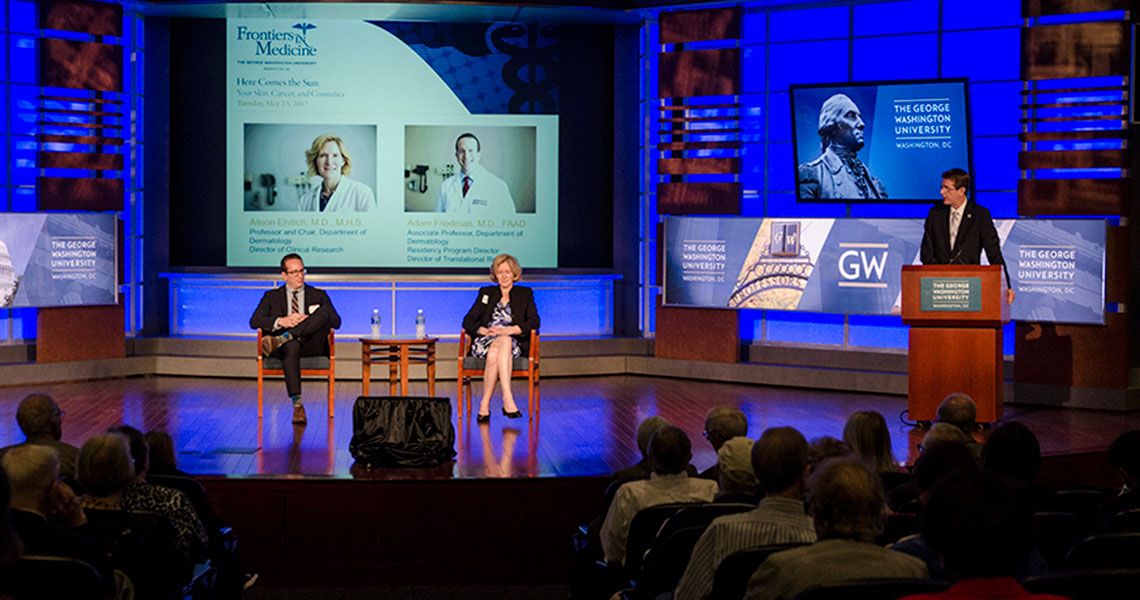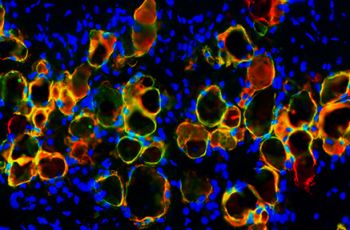How to protect your skin, what products to use to do so, and the ways in which people can reduce signs of aging were featured topics at the most recent George Washington University (GW) School of Medicine and Health Sciences (SMHS) Frontiers in Medicine lecture on May 23.
The advice and information provided by Adam Friedman, M.D., FAAD, associate professor of dermatology and residency program director in the Department of Dermatology at SMHS, and Alison Ehrlich, M.D., M.H.S., professor and chair of the Department of Dermatology at SMHS, came as the sun-filled days of summer drew near.
Friedman spoke about how to prevent skin cancer and effects on skin from the sun, along with the dos and don’ts of sunscreen. “The health of our skin is determined by so many different factors, both internal and external. It is exceedingly complicated,” Friedman said. Those factors can include sunlight exposure, smoking, and even pollution, he added.
Because of the complicated landscape, it can be hard for people to know what products are best for their skin. “My philosophy when it comes to selecting a product is ‘show me the science,’ ” he said. “Do we understand the mechanism of how these products work and the ingredients they’re touting? Do we have any clinical data?”
First, he said, it’s important to know what is causing accelerated skin aging before steps can be taken to prevent it. One way damage forms is through the effects of free radicals, which Friedman called “homewreckers.”
“A free radical is a super-charged radical that just wants to make a pair for its unpaired electron,” he explained. “It wants to find a mate in life, and what it’s going to do is steal your mate, your electron.”
These free radicals can’t be avoided because they form as we go about our day-to-day, he added, but external factors — ultraviolet radiation, pollution, smoking — lead to more.
Because of that, many people turn to antioxidants, which can give that unpaired electron its pair. For an antioxidant to work, Friedman cautioned, it has to get through the skin and into the skin cells, which is not an easy feat. He added that consumers should be wary of over-the-counter products that may overstate their effectiveness.
Ehrlich’s portion of the lecture focused on how to address the negative aspects of sun exposure, from more serious issues like cancer to damage such as wrinkles and sun spots.
Sun exposure is one of the leading causes of skin cancer, she said. “When we’re educating patients about what to look for on their skin … we tend to look for lesions that have asymmetry, irregular borders, and variations in color,” she explained.
For sunscreen, both noted that it should be used every day, even on a day as cloudy and rainy as the one on which the lecture was held. In addition, consumers should purchase a sunscreen that is broad-spectrum, meaning it protects from both UVA and UVB rays. Sunscreen also should be applied 15 to 20 minutes before heading outdoors, and should be reapplied every two hours or after you get out of the pool.
Friedman also discussed the future of sun protection. “[F]or me, my heart is with nanotechnology,” he said, which he defines as the investigation and manipulation of materials that are between one and 100 nanometers in size. For scale, according to the National Nanotechnology Initiative, a single strand of human DNA is 2.5 nanometers thick.
Nanotechnology could help create a sunscreen product from UVB-blocking plant chemicals like curcumin — which usually would stain the skin and clothes—that is basically translucent. “You can dilute [curcumin’s] color … making it more amenable to topical application” without losing its potency, Friedman said.
But, even for people who are rigorous with their skin protection regimes, time has a way of making its mark. The procedures Ehrlich performs at GW help treat the effects of aging, as well as from skin cancer.
“What happens with aging? We get pigmentation, we get wrinkles, we also get broken blood vessels on the face and legs. These are all things we can treat,” she said.
Treatments include bleaching creams, chemical peels, intense pulse light therapy, fillers, and fractionated resurfacing. There’s also a new agent, Kybella, where a detergent is injected into the chin area to tighten the skin and reduce the fat pad. Another new treatment is CoolSculpting, Ehrlich noted, in which they reduce the fat by freezing it.
“We like to try to figure out for all our patients what’s the best way to get them looking as wonderful as they can be for their age,” she said.



